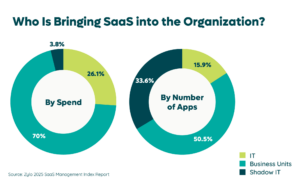Table of Contents
Enterprises rely on application portfolio management (APM) best practices to ensure their software aligns with core business needs.
As licenses quickly shift from on-premise to the cloud, APM evolves to include inventorying and unlocking insights on your SaaS applications, rationalizing your portfolio, and creating a programmatic process to drive future success.
The goal of application portfolio management is to not only align operations and enterprise architecture to ensure you obtain and use the right business tools, but also drive ROI and productivity across the organization.
APM best practices help enterprises understand the scope, value, and true costs of their SaaS portfolios and provide actionable data to help them rationalize their licenses over time.
Regardless if you’re an experienced SaaS Manager or just starting out, let’s explore some of the application portfolio management best practices to help your company get the most out of your SaaS investment.
APM Best Practices: 3 Strategies for Success
1. Designate an application portfolio manager focused entirely on SaaS
Enterprise organizations typically have the resources to employ a substantial team to support their IT architecture and application portfolio management functions. Increasingly, we’re seeing more companies hire a dedicated SaaS manager, one who serves as an effective liaison for collaboration across the organization.
This was the case at Atlassian, where Leah Tubb, Program Manager of IT Architecture, Planning and Innovation, was tasked by senior leadership to dig in and understand their actual SaaS investment. To Tubb’s surprise, the answer wasn’t straightforward, and she compares the process to peeling back layers of an onion.
“I thought we could answer that pretty easily but then, as we started to look into it…It just kept going and going and going, and each of those was a layer we were trying to figure out.”
With SaaS now the largest public cloud services market segment—forecasted to reach $299B in end-user spending in 2025—and also expected to become the most dominant type of all software in the next three years, the business case for establishing an application portfolio manager becomes crystal clear.

2. Gain visibility into your entire application portfolio
Effective application portfolio management always begins with discovery, because you need to not only uncover all tools in your arsenal, but understand how much you’re spending, the source of SaaS purchases, and any redundancies and duplicate applications.
Unlike with on-premise tools that typically undergo vetting and central oversight from IT, you’ll likely find SaaS spread out across the organization. For instance, Zylo data shows individual employees and business units managing a majority of SaaS spend, with IT controlling just 16%.

A dedicated SaaS Management platform surfaces all SaaS purchases across your organization in a central system of record, including IT-managed, line-of-business owned, and shadow IT. Combined with real-time utilization and spend metrics, you can make data-driven decisions to optimize your investment.
3. Rationalize duplicate and redundant applications
With clear visibility into your SaaS stack, you can begin to rationalize duplicate and redundant applications, taking into account what makes most sense for the business from both a functional and financial standpoint, and determining where you can consolidate applications with overlapping functionality.
However, it’s important to note you may discover redundant tools that perform a similar function, such as data security or project management tools. But it’s not necessarily a bad thing, says Chris Asing, Head of Business Technology at Redis, in a recent episode of Zylo’s SaaSMe Unfiltered podcast. For example, he says a project workflow tool may work well for IT, but sales and marketing may prefer a different workflow tool, often due to application maturity or available integrations.
“While it may be duplicative, it’s actually serving that function significantly better than my product would be serving their function, because the products themselves haven’t matured,” Asing says. “Everyone’s sort of saying, ‘Look, I work with products A, B and C, but this one works with X, Y, and Z.’ We sometimes find ourselves in a situation where we are deliberately taking on two tools that do a very similar thing, but are compatible with their domain of tools.”
In closing, a well-governed application portfolio management framework helps enterprises discover all software lurking across the organization and spotlights accurate pricing and utilization data, so you can determine the true ROI of each tool and ensure it moves the organization forward.
To dive deeper on application portfolio management best practices, check out how Atlassian improved visibility into applications and services and implemented a successful SaaS governance model for its distributed workforce of more than 4,500 employees.
Atlassian Reinforces Enterprise Architecture with Zylo SaaS Management
Learn how Atlassian’s enterprise architecture uses Zylo to encourage innovation and rapid growth while constantly rationalizing their application portfolio.

